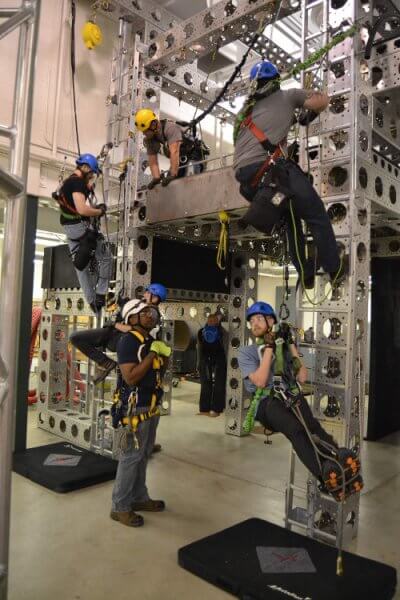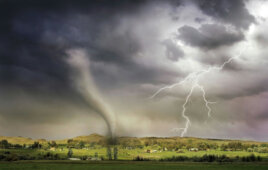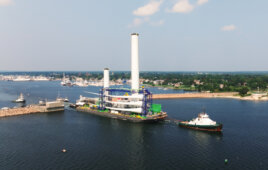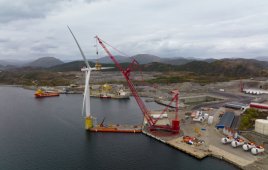By Sam Heim, Media Specialist, Petzl
The wind technician career is projected to have the highest job growth rate in the United States for the next eight years. According to the Bureau of Labor Statistics, the projected percent change in employment from 2019 to 2029 for wind techs is 61%; the average job growth rate for all occupations is 4%.

Training at KVCC
Scott Conner, the chief of training at Team 1 Academy in Ontario, Canada, theorized that along with the increase in towers going up, there’s also more turnover in North American wind techs due to the physicality of the job. “People get burnt out; most people can’t climb for 20 years,” he said. “But, there are also more turbines going up.”
ENSA Access + Rescue, based in Mukwonago, Wisconsin, is a training organization that offers wind, telecom, residential roofing and general industry courses. Rob Siegel, executive director of ENSA North America, said they’ve doubled in size every year for the past three years. “Wind is the reason we’ve been able to hire and partner with more schools to increase our bandwidth,” said Siegel.
Kalamazoo Valley Community College (KVCC) offers an exceptional wind program, headed by Tom Sutton, director of wind energy and technical training services, since 2013. Sutton took a lead role in the design of the wind program and understands not only the importance of a mechanical and electrical background but also competency in rescue and risk management. KVCC offers a 24-week program, and the first 160 hours of training is focused on “nothing but rescue and safety,” said Sutton. The first 80 hours specifically are focused only on rescue techniques.
Zev, a December 2020 graduate of the KVCC wind school currently works with one of the largest companies in the industry. “Tom Sutton is one of the best in the industry, and I definitely felt prepared for a career as a wind tech,” Zev said. “I wanted to combine my passion for climbing with my electromechanical engineering technology degree, and being high up is so enthralling and beautiful.” Thankfully, Zev hasn’t had to perform a rescue during his short time as a wind tech, even with the preparation at KVCC.
However, non-life threatening rescues can occur, and competency in an assisted self-rescue is imperative for wind techs. “The nice thing about training now, compared to 15 years ago, is that people can attend wind schools and learn skills like negotiating an edge, which gives us at ENSA the opportunity to teach high commodity skills like advanced rescue techniques,” Siegel said.
ENSA recently added the JAG RESCUE KIT to its advanced rescue training program. “We’ve been using mechanical advantage systems for years, but students always appreciate a pre-rigged system vs. building their own in the moment,” Siegel said.
Petzl developed the JAG RESCUE KIT for quick rescues. It’s designed for easy pick-offs with a 4:1 mechanical advantage. Pulley sheaves are mounted on sealed ball bearings, and a flexible cover around the 8-mm haul rope gives the user a compact and tangle-free rescue option. Both ends are color-coded to differentiate the victim and operator end.
 The latest version of the JAG is equipped with an I’D EVAC, designed with a handle specifically oriented to allow for comfortable descent control when lowering from the anchor. The I’D EVAC is used by pulling on the handle and controlling the descent speed by holding the brake side of the rope as it slides through an auxiliary friction brake. An anti-panic function limits the risk of an accident due to uncontrolled lowering. Self-braking descenders provide rescuers the option to perform an accompanied or unaccompanied rescue operation depending on psychological, environmental and physical obstruction factors.
The latest version of the JAG is equipped with an I’D EVAC, designed with a handle specifically oriented to allow for comfortable descent control when lowering from the anchor. The I’D EVAC is used by pulling on the handle and controlling the descent speed by holding the brake side of the rope as it slides through an auxiliary friction brake. An anti-panic function limits the risk of an accident due to uncontrolled lowering. Self-braking descenders provide rescuers the option to perform an accompanied or unaccompanied rescue operation depending on psychological, environmental and physical obstruction factors.
Conner, who leads the advanced hub and blade rescue course at Team-1 Academy, also incorporated the 5-m JAG to its kit. “It’s a godsend for the advanced rescue because I have more room to move the patient in the blade,” he said. “And if you want to make it foolproof, buy the system.”
Bruno Pinard, the principal training consultant and Petzl technical specialist at Nouvelle Hauteur, a fall protection, rescue, rope access and confined space training center based in Quebec, said, “We use the JAG on everything from evacuation to a pick-off to a confined space to a blade rescue.” Pinard has found the 1-m JAG is more convenient for pick-off rescues. “It’s great for hauling and lifting, not just evacuations.”
An increase in employees, for any industry, can potentially increase the number of accidents and under-trained individuals. It only takes one accident for a serious injury or death. “A student told me about a rescue he had to do for someone who had a heart problem in the cell, and it was an eye-opener for him because it had been a while since he’d practiced,” Pinard said. “I see more techs taking rescue training because they realized how important it is, especially after being in a real rescue.”
Conner echoed a similar sentiment, noting an increase in companies relying on outside organizations, like Team 1 Academy, to train their employees instead of managing safety training within the company.
“I’ve seen many contractors requiring wind techs to have GWO certified courses,” Conner said.
A Denmark-based organization, Global Wind Organisation (GWO) has been the leader in providing an “injury-free work environment in the wind turbine industry, setting common international standards for safety training and emergency procedures.” For an industry to see substantial growth, like what the wind industry is currently experiencing, it begs the question of who identifies and sets training standards? As of now, there are no ANSI standards regulating the wind industry.
When not managing the wind school at KVCC, Sutton also sits on several committees, and has a heavy hand with the “DC side of wind.” He recently assisted in writing an ANSI standard for rescue and climb training. It will be the first ANSI standard for the wind industry, once it goes through public comment.
There are several resources and organizations that provide training in North America and ENSA, Team-1 Academy, Nouvelle Hauteur and Kalamazoo Community College are some of the best out there. An increase in wind technician careers hopefully means an increase in a healthier and cleaner future for us all.
Former student Zev summarized it well: “I’m passionate about the environment and wanted to give back. I realized I could go into this field and keep the wind turbines spinning.”
Filed Under: Featured, Safety, Services, Training




